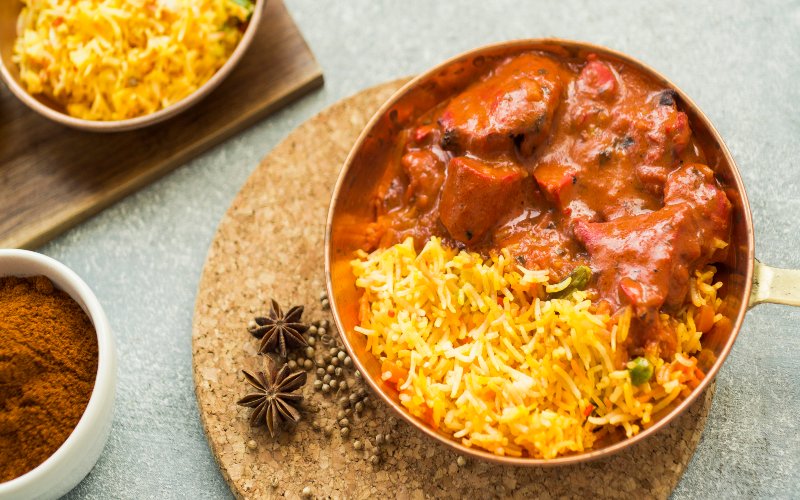Mouthwatering differences between Somali and Swahili biryani

Across the Horn and the coast, one bite of biryani connects centuries of trade, migration, and shared humanity, proof that diversity enriches rather than divides.
Biryani, the aromatic, spice-laden rice dish that signals celebration and community, has taken on countless regional identities worldwide.
In East Africa, two beloved versions stand out: Somali biryani and Swahili biryani. Though they share a foundation of rice, meat, and spices, they differ profoundly in flavour, texture, cooking technique, and cultural meaning.
More To Read
- How to make a healthy Caesar salad at home with these simple steps
- How to make mouth-watering pilau for family and friends
- Beef biryani ingredients
- How to make yummy beef biryani at home
- How to make yummy beef biryani at home for friends and family
- From chai to pilau: The best spices to keep you warm this cold season
To understand these differences is to travel through time, from ancient trade routes and nomadic traditions to coastal kitchens rich with shared history.
The story of biryani in East Africa begins centuries ago, when Indian and Arab traders brought their culinary traditions along the Indian Ocean coast. Ports like Mogadishu, Mombasa, and Zanzibar became vibrant melting pots, where spices from India met African grains and Arabian techniques.
In Somalia, biryani adapted to local tastes shaped by inland trade and nomadic life, hearty, spicy, and meat-forward. Along the Swahili coast, biryani evolved under the influence of Indian and Persian cooking, emphasising fragrance, finesse, and layered presentation.
Thus, two distinct dishes emerged from one origin, connected by trade and migration, yet moulded by geography and identity.
Somali biryani: A bold expression of spice and strength
Somali biryani (bariis iskukaris, meaning “mixed rice”) reflects Somalia’s deep connection with spice trade routes and pastoral culture. It is robust, colourful, and unapologetically bold.
1. Flavour and spice
If you want to experience authentic Somali biryani, AK’s Restaurant in Eastleigh is a must-visit. Prepared by a seasoned Somali chef who understands the craft to its core, the dish captures everything that makes Somali biryani remarkable.
It thrives on bold, unapologetic strength, a masterful balance of spices where black pepper, cardamom, cumin, cloves, and cinnamon take centre stage. Tomato paste lends richness and tang, while green chillies, which are often added on the side after serving, add a satisfying kick.
The result is a deep, full-bodied sauce that coats every grain of rice and tender piece of meat, delivering warmth, complexity, and a flavour which lingers long after the last bite. Sweet, but with a mild, manageable heat.
2. Cooking method
Unlike Swahili biryani’s signature layering technique, Somali biryani often embraces a more rustic and unified approach, cooking the rice and meat together in one pot.
However, this is not universal; some Somali households prefer to prepare the rice and meat separately, marrying them only at the final stage for a lighter texture and distinct layers of flavour.
Traditionally, the process begins with browning onions and garlic in generous oil until golden and aromatic, then setting aside for later use.
Chunks of meat, often goat, beef, or chicken, are added, searing until the edges caramelise and release their juices. A medley of spices and tomato paste follows, creating a rich, fragrant base that defines the dish. When the rice joins the pot, it soaks up the seasoned broth, ensuring every grain is infused with the essence of the meat and spices.
This technique reflects Somalia’s nomadic roots, where simplicity and resourcefulness shaped cooking traditions. One-pot biryani is practical yet deeply flavourful, a dish designed for families on the move, built around efficiency, nourishment, and communal sharing.
3. Signature characteristics
Visually, Somali biryani boasts deep orange, yellow, or reddish hues from tomato paste or turmeric.
Garnishes like fried onions, raisins, and boiled eggs add sweetness and texture, making it a rich, filling dish for family gatherings, weddings, and religious feasts like Eid.
4. Cultural essence
For Somalis, biryani represents hospitality and abundance. Served on large communal platters and eaten with fingers, it embodies Somali identity: resourceful, warm, and proud, leaving a lasting impression with its bold flavours.
Swahili biryani: Fragrant, layered, and coastal
Swahili biryani, found along Kenya’s and Tanzania’s coasts, tells a different story, a tale of cultural fusion and coastal refinement. It is as elegant as the palm-fringed towns where it was perfected.
1. Flavour and balance
Swahili biryani favours aroma and balance over intensity, using cinnamon, cardamom, cumin, cloves, nutmeg, and sometimes rosewater or saffron. Coconut milk lends creaminess and subtle sweetness, a hallmark of Swahili coastal cuisine.
2. The layering technique
Unlike the Somali method, Swahili biryani involves dum cooking. Dum cooking (also known as dum pukht) is a traditional slow-cooking method that originated in the royal kitchens of India and Persia.
The word dum literally means “breath” or “steam”, and it refers to cooking food in its own steam, a process that allows the flavours, aromas, and moisture to blend and intensify beautifully over time.
The meat, cooked in a masala of onions, garlic, ginger, and tomatoes, forms a rich, thick stew. Parboiled rice is then layered on the masala in alternating tiers, sprinkled with saffron or food colouring for colour contrast, and steamed gently in a sealed pot. This creates distinct layers: fluffy white rice on top, golden-orange rice in the middle, and deeply flavoured masala below.
3. Accompaniments and presentation
Never served alone, Swahili biryani is accompanied by kachumbari (a zesty onion-tomato salad), coconut chutney, spicy pili-pili sauce, or ukwaju drink. These condiments balance richness with freshness, creating a sensory dance of contrasts.
4. Cultural context
In coastal towns, biryani is synonymous with celebration, weddings, Eid, Ramadan, iftar, and Sunday family lunches. The dish embodies the essence of Swahili culture: gentle, hospitable, and steeped in centuries of cultural exchange between Africa, Arabia, and India.
The divergence between Somali and Swahili biryani goes beyond recipes; it is about lifestyle, geography, and philosophy.
Geography: Somalia’s dry inland climate favours hearty meat and spice; Swahili coastal areas favour spices, coconuts, and fresh produce.
Technique: Somali biryani is rustic and hearty, often one-pot; Swahili biriyani is delicate, structured, and layered.
Flavour: Somali biryani is fiery, oily, and intense; Swahili biryani is perfumed, balanced, and soothing.
Cultural symbolism: Somali biryani is a feast of family strength and unity; Swahili biryani symbolises elegance and social grace.
Ultimately, Somali and Swahili biryanis share a spirit of community, generosity, and joy in cooking.
Somali biryani is a bold storyteller bursting with spice and heart, while Swahili biryani is poetry on a plate, refined, rhythmic, and gracefully layered.
Both remind us that food is history you can taste.
Top Stories Today













































